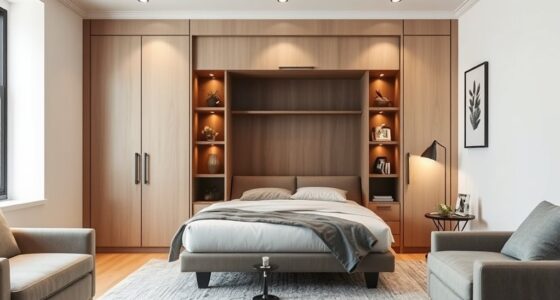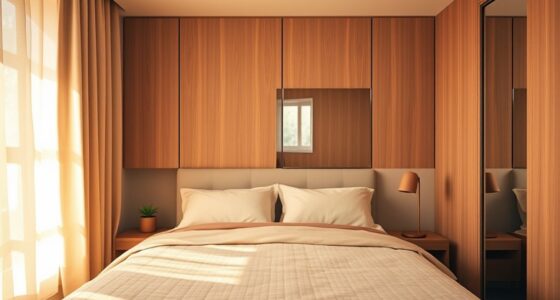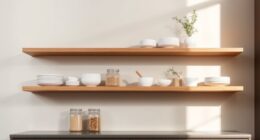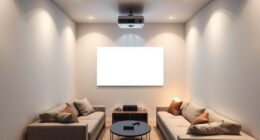When evaluating multipurpose furniture, focus on how well it balances functionality, aesthetics, and space-saving features. Check if it offers easy transformations with smooth mechanisms and sturdy builds for daily use. Assess storage options, ensuring hidden compartments don’t compromise the design. Consider how the piece complements your decor style and fits the room’s size to avoid clutter. If you’re curious about making the best choice, exploring these tips will help you choose the perfect pieces for your space.
Key Takeaways
- Assess furniture for seamless multi-functionality and smooth transformation mechanisms for ease of use.
- Confirm space-saving design with hidden storage options to reduce clutter and maximize utility.
- Ensure style compatibility and aesthetic versatility with existing decor for visual harmony.
- Check construction quality and durability for frequent use and long-term performance.
- Measure room dimensions to select appropriately scaled pieces that enhance space efficiency.

Have you ever considered how to maximize space while adding style to your home? Multipurpose furniture is an excellent way to do that, especially if you’re working with limited square footage. When evaluating such pieces, focus on how they serve multiple functions without sacrificing aesthetic appeal. Space saving solutions are at the core of multipurpose furniture, making it ideal for small apartments, studios, or rooms that need to do double duty. But beyond just saving space, you want furniture that offers aesthetic versatility, blending seamlessly with your existing decor and adding an element of design rather than detracting from it.
Start by considering the furniture’s primary function and how well it integrates with your lifestyle. For example, a sofa bed isn’t just a place to sit; it transforms into a bed when needed, saving you the space and expense of a separate guest room. Look for pieces that offer easy transformation—smooth mechanisms and sturdy construction are key. This ensures you won’t struggle to switch between functions, making your space more flexible and functional. When evaluating these options, think about how much space they occupy when in use versus when stored or folded away. The goal is to find solutions that can adapt to your daily routines without cluttering your environment.
Additionally, many multipurpose pieces incorporate hidden storage, helping you keep clutter out of sight while maximizing utility. Next, assess the aesthetic versatility of the furniture. Does it match your personal style? Will it complement your existing furniture or stand out as a statement piece? Multipurpose furniture comes in various styles, from sleek modern designs to rustic or vintage looks. Choose pieces that can blend seamlessly into your space, maintaining harmony and visual balance. Consider the color, material, and overall design; a well-chosen piece should enhance your decor rather than disrupt it.
Durability is another critical factor. Since multipurpose furniture often undergoes frequent transformation, you want sturdy construction that can handle regular use. Check the quality of hinges, joints, and fabrics or finishes. A durable piece not only lasts longer but also maintains its aesthetic appeal over time. Additionally, think about storage capacity if relevant—some furniture offers hidden compartments or drawers that maximize functionality without adding visual clutter.
Finally, think about the size and scale of the furniture relative to your space. An oversized piece might dominate a small room, whereas a compact, well-designed item can fit effortlessly. Measure your space carefully before making a decision, ensuring that the furniture enhances rather than overwhelms the room. When you choose multipurpose furniture thoughtfully, you’ll create a more efficient, stylish living environment that adapts to your needs and personal taste.
Frequently Asked Questions
How Do I Determine the Durability of Multipurpose Furniture?
You can determine the durability of multipurpose furniture by checking the fabric quality and weight capacity. Opt for high-quality, tightly woven fabrics that resist wear and tear. Look at the weight capacity to ensure it can handle your intended use without strain. Test the furniture’s construction by inspecting joints and frames for sturdiness. Choosing well-made, durable materials guarantees your furniture will last longer and withstand daily use.
What Materials Are Best for Long-Lasting Multipurpose Pieces?
You’ll find that solid hardwoods like oak or maple are the best for long-lasting multipurpose pieces because of their high material quality and durability. Metal components, especially steel, add strength and longevity, while high-quality plywood offers a good balance of strength and design versatility. Avoid cheap particleboard or flimsy materials, as they tend to wear out fast. Prioritize well-constructed furniture with sturdy joints for lasting use.
How Can I Assess the Safety Features of Multifunctional Furniture?
You should check for child safety by inspecting the furniture for secure locking mechanisms and smooth edges. Conduct stability testing by gently rocking or pushing the piece to see if it wobbles or tips easily. Look for safety certifications or labels, and read reviews for any safety concerns. Prioritize furniture with rounded corners, sturdy construction, and anti-tip features to guarantee it’s safe for all users.
Are There Eco-Friendly Options for Versatile Furniture?
You’re in luck—there are eco-friendly options out there! Many eco-conscious brands now use sustainable materials like bamboo, recycled metal, and reclaimed wood, making versatile furniture both stylish and green. These brands prioritize eco-friendly production methods, so you can be confident your furniture is good for the planet. Keep an eye out for certifications like FSC or Green Guard to guarantee you’re choosing truly sustainable pieces.
How Does Multipurpose Furniture Impact Room Layout and Design?
Multipurpose furniture impacts your room layout by enabling better space optimization, allowing you to maximize smaller areas efficiently. It encourages a more flexible design, seamlessly blending with your aesthetic to create a cohesive look. You can easily adapt your space for different activities, making your room feel less cluttered and more functional. With thoughtful integration, multipurpose pieces enhance both the usability and visual appeal of your living space.
Conclusion
Now that you know how to evaluate multipurpose furniture, you’re ready to make smart choices that fit your space and lifestyle. Remember, it’s all about finding pieces that serve double duty without breaking the bank. Don’t be afraid to think outside the box—sometimes, the best furniture is the one that wears many hats. With a little patience and keen eye, you’ll turn your home into a versatile haven where form and function go hand in hand.









